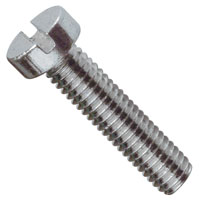Why LUBRICATE Stainless Steel fasteners?
You may ask yourself why should there be a need to apply lubrication to Stainless Steel Fasteners? After all they are Stainless, they should not need lubrication, they will not corrode. This section of the website attempts to explain why lubrication should be used to prevent two seperate possible issues, the possible results of not doing so and how this need has arisen. The intention is not to try and confuse or over complicate the issues, just attempt to provide some answers to problems that spasmodically can occur when assembling Stainless Steel Fasteners.
FIRSTLY LET US POINT OUT THIS IS NOT AN ISSUE THAT OCCURS REGULARLY, SO DO NOT PANIC, READ ON AND BECOME AWARE OF THE POSSIBILITY OF 'GALLING' . INDEED, IT IS SO INFREQUENT THAT WE RECEIVE LESS THAN 1 INSTANCE PER YEAR, BUT THAT IS 1 CALL OR EMAIL TOO MANY.
THIS PAGE WILL ALSO OFFER INFORMATION ON ANY POSSIBLE REACTION BETWEEN THE STAINLESS FASTENERS AND THE ALLUMINIUM ENGINE CASINGS AND HOW TO BEST AVOID IT HAPPENING TO YOU.
GALLING The problem is often referred to as 'thread galling' or another description used has been 'cold welding', quite simply the two fastener components become unexpectedly locked together as if they had been welded. The nut may in fact not even be fully tightened down onto the male thread, or the male thread will become locked into the tapped area it is being inserted into. The only way to release the items is to saw through the male thread and remove the nut, or in the second scenario saw through the bolt shank and then start the laborious job of drilling the pre-tapped hole out until you can either install a wire insert into the original thread (if there is enough left of it) or drill and re-tap the hole oversize. To help avoid this LUBRICATE your fastenings properly before assembly.
REACTION BETWEEN STAINLESS & ALLUMINIUM Without getting too technical problems can occur betwwen the two metals as they are dissimilar metals and once salt water moisture is involved a reaction can start occuring. The technical terminology is GALVANIC CORROSION (web searchable) it is highly technical and not really a subject for in depth discussion on this website (i will leave that with the Metallurgists. In its most basic format Stainless Steel can (under salt water moisture situations)corrode or 'eat' Alluminium. However, do not dispair as the whole theme of this page is highly relevant to this issue; LUBRICATE your fasteners properly before assembly as the lubricant will form a barrier between the two metals and also dispell moisture. Reaction can only occur when the two different metal are actually in contact with each other. The reaction between Standard Steel Fasteners and Alluminium is potentialy even more catastrophic as this is a more corrisve mixture than Stainless, this is why Standard Steel bolts are always PLATED, but what happens when the plating wears or corrodes off?
In the vast majority of cases this can be avoided by lubricating the fasteners before assembly(we will not recommend any specific brand of lubricant but a relatively simple web search will turn up many such brands, basically anything that forms a film between the items)Once lubricated the chances of locking become vastly diminished as are the chances of cross metal corrosion.
This phenomena occurs mainly with Stainless Steel, Titanium, Aluminium and other alloys that generate a film which provides corrosion resistance. As tightening increases pressure and heat becomes generated these oxides become disturbed and a chemical reaction is started between the two objects that can ultimately lead to thread locking.
We do not claim to be totally immune from the problems of 'galling' but do our best to try and prevent it happening as much as possible. However, even our process's still require you TO LUBRICATE BEFORE ASSEMBLY, the best form of prevention lies with you ultimately, the user.
Thank you for reading this document, we hope it has been informative and to have been of some assistance

